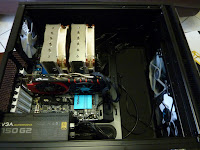Let continue where we left of in Part 2A of your system
building project. In Part 2A we covered installing the CPU, CPU cooler,
motherboard and SSD into our computer case, in this part we will finish
assembling the rest of our system.
Installation Steps
Case Fan, PSU, PSU Cable Routing
The next component we have decided to install is an additional case fan at
the front of our case. This Noctua fan is larger and more powerful than the fan
that comes with the case and we have positioned this fan in a more direct line
to the CPU and GPU on the motherboard to provide the required air to keep the
system components running cooler than the stock case. This is especially worth
considering since both the CPU and GPU in our system can be overclocked, which
puts more stress on the overall system and the system components run hotter
when overclocked.
We can now go ahead and install the Power Supply Unit (PSU), we simply slide
the PSU from the back of the case into place and screw into place along the
back of the case. We have made sure the PSU intake fan is facing down so that
fresh cooler air is provide to the PSU not the hotter air generated inside the
case by the other components. We can now also check the cables that will be
required by the whole system and connect them to the PSU, feeding them to the
back of the case via the cable slot at the bottom of the case in preparation to
connect to the components later on.
In our example there is an additional component that should be installed
next, this is the WiFi card which is connected to the Mini PCIe slot. Since
this will be located underneath the GPU we will install this first by
connecting the WiFi signal cables from the card to the back of the case where
the antenna connections are located.
The GPU can now be installed relatively easily into the PCIe slot and
orientation should not be an issue since the connections on the bottom of the
card and the design at the back of the card which will align with the back of
the case mean it will only fit onto the motherboard in one direction. We need
to make sure that we have removed the back-cover on the case which aligns with
the PCIe slot in which we will be connecting the GPU and when inserting
the GPU into the slot to first release/hold open the PCIe plastic lock
of the PCIe slot on the motherboard, otherwise the GPU will not sit in
the slot and you may damage the card trying to force the matter. Once in place
we can screw the card into place at the back of the case where we removed the
back cover.
Case Input/Output, Cabling Connecting, Post and Troubleshooting
Now that all the major components have been installed into their final positions
on the motherboard/case we can finish all the cabling from the PSU. We can
connect the two power cables required by the motherboard running from the PSU,
the 8-pin and 6-pin power cables for the GPU can be connected (some graphics
cards require only a single power cable), the power cable for the SSD from the
PSU and the data cable from the SSD to the motherboard SATA slot can also be
connected.
In all the cabling it is best to feed the cable from the bottom and back out
the front via the closest cabling hole on the case for each component. This
helps keep the cabling as clean as possible which helps when we need to remove
any components in the future and as well as keeping the case internals
aesthetically pleasing, this also helps when we tie up the cables at the end of
the build and when we try to clean the system periodically.
A tip worth remembering is to clean the system from the inside of any
dust buildup every 3-6 months to reduce any additional trapped heat, ensure the
components are working optimally and to ensure maximum air flow throughout the
case. A can of compressed air will provide enough force to help remove any
stubborn dust as physically dusting the components with your hands may damage
components and is not recommended.
Next we can connect the case fan power cables to the motherboard. There are
two types of case fans available on the market, PWM and voltage regulated fans.
The type of fan on your case will determine which fan connector on the
motherboard you will use to connect each fan. PWM fans work optimally and allow
for more control via the motherboard bios/software when connected to 4-pin fan
connections. In our example we have connected two fans from the front and one
fan from the back of the case.
Lastly we can connect the case input and output connections that are
generally included at the front of most cases, these include the power button,
reset button and USB ports. Most of these connections are situated close to
each other on our motherboard which makes it easier but referring to the
motherboard manual is crucial to ensure that the connections are positioned in
the right location and the right orientation. If your system does not power on
via the case button, incorrectly connecting these connections may be a likely
cause.
Once we have this final step completed we can go ahead and connect the
computer monitor, keyboard, mouse, PSU to the wall socket for power, turn on
the PSU from the back of the case and test the system starts correctly without
any error messages /sounds from the motherboard. Successfully booting the
system should take you into the motherboard bios screen.
If the system did not boot correctly you will need to troubleshoot the
problem by determining what error sounds the motherboard generated and then
cross referencing with the motherboard manual to determine the correlated
problem associated with the sound. You can find more help with any problems on
the websites highlighted in the next section.
Support and Knowledgebase
I have tried to be as clear as possible in the steps outline above but if
you are still unsure about a specific step or need any question answered about
an aspect of your system build I would recommend checking out some of the more
popular online resources for help and guidance. The first place I would
recommend to get help would be the component manufacturer website/forum as they
would have the most accurate information about the subject, but there are many
knowledgeable and helpful users on technology forums such Linustechtips,
Tomshardware and Reddit who can also provide the help you require. I would also
recommend checking out some related videos on YouTube as it has also been a
very helpful resource for me when selecting components and building the system,
with people posting helpful videos reviewing PC components and guides on
building computer systems.




That concludes Part 2 of our mainstream and upgradable computer system build
guide and I hope it was helpful, stay tuned for the third part where we will
cover some of the important software related aspects of building a computer
system such as OS installation and setup.
Related Resources
http://linustechtips.com/main/
http://www.tomshardware.com/forum/
https://www.reddit.com/
https://www.youtube.com/
http://www.pcauthority.com.au/Review/390171,review-asrock-z97-extreme6.aspx
Welcome back to more adventures in building our own computer
system. In Part 1 we discussed the components that we were going to select as
part of our mainstream and upgradable computer system build as well as some of
the popular places to purchase these components with the help of online
services. In this part we will be covering some of the important considerations
when actually assembling your computer on your own and the steps to take in
doing so.
Requirements
-Philips screwdriver /screwdriver kit
-Clean not static work-space
-Monitor, keyboard, mouse for testing
Unboxing and Preparation
The first thing we should do is unbox all the components and check that
nothing is damaged and that everything stated is in the box with nothing
missing. This will reduce the chances of having to stop the build mid-way to
remove and replace any damaged components. When handling any components make
sure you don't have any static built up on you that may damage the components
and don't place them on anything where static transfer may occur. Also it is
worth while reading the documentation provided with each component carefully to
understand how best to install the component without making any mistakes. The
figures below show all our example system components unboxed and undamaged
ready to be installed.
Installation Steps
CPU, RAM, Back-Plate, Motherboard, Cooler Mount
The first component we will install is the CPU into the socket on the
motherboard. We could have left this after we installed the motherboard into
the case but it becomes darker and more cramped inside the case so it is
generally best to do this step before installing the motherboard. Before
installing the CPU it’s a good idea to visually inspect the pins on the
underside of the CPU to insure none are bent out of place. The CPU will only
fit one way and a notch on the corner of the CPU should align with a similar
looking notch on the motherboard (Note: don't force the CPU into place, it
should sit in gently).
The next component we can easily install at this moment is the ram. The ram
only installs in one orientation due to the notch at the bottom of the ram
modules, which are slightly offset of middle of the module. Opening the side
locks of the ram sockets on the motherboard, placing the ram modules in the
right direction and pushing down slightly until they click into place. The side
locks may or may not lock automatically due to the force once the ram is in
place, checking they are locked is recommended.
It is a good idea to install any CPU cooler mounting sockets now since the
back of the motherboard may not be accessible once it is installed into the case.
This socket will allow for proper seating of the CPU cooler onto the CPU and
will ensure a firm connection to the motherboard. The style of mounting socket
and the steps on how to install the socket will be different depending on the
CPU socket and the CPU cooler. Therefor it is best to refer to the
documentation provided by the cooler manufacturer to ensure the socket is
installed correctly.
Let’s install the back-plate for the motherboard into the case now as
well since it will be difficult if not almost impossible to install it after
installing the motherboard. Simply make sure the plate aligns correctly to all
the input and output connections with how the motherboard will be positioned in
the case and push the plate into place.
The next step is to screw in the motherboard standoffs into the case which
in which we will connect and screw in the motherboard. The position of the
standoffs will be determined by the size/form factor of the motherboard being
installed (ATX, Micro-ATX, Mini-ITX) and the case design. The exact positions
should be outlined in the case manual/reference guide.
Some people connect the GPU and PSU cables at this point to test the
system is working correctly and it is advised to do so if you are concerned
about the system not starting up. It is easier to do this step now since any
problems later in the build process may mean that we need to disassemble the
system and remove the motherboard out of the case, which can be a hassle and
time consuming process.
Once the standoffs are positioned correctly we can finally install the
motherboard into the case. Being careful and gently handling the motherboard to
avoid putting any unnecessary stress that may damage any components on the
motherboard, we align the motherboard with the back-plate. We slowly place the
motherboard on top of the standoffs making sure not to slide the motherboard
around too much as this may scratch and damage the underside of the
motherboard. Referring to the motherboard and case manuals we screw in the
motherboard from above into the previously installed offsets. Ensure the screws
are firmly in place but avoid tightening the screws too much as this may also
damage the motherboard.
CPU Cooler and SSD
What’s next you ask, well good question, we will install the CPU cooler onto
the CPU cooler mount that we installed previously, making sure the cooler is aligned
the way we prefer/require. In the case of our Noctua cooler we also need to
make sure to place the provided thermal paste on the CPU before placing the
cooler in place, a pea sized drop in the center is often recommended as placing
the cooler on top will force the paste to spread out into place evenly. Once
the cooler is in place we have attached the accompanying fans making sure they
are oriented in the right direction based on the marking on the fans, in our
case pushing the air out through the back of the case.
It is a good idea to check if any power connections that we require such as
for the motherboard are situated underneath the CPU cooler and to connect them
to the motherboard at this time before installing the CPU cooler to avoid
issues with not having easy access to the connections after the cooler is
installed. This is not as much of an issue when installing a water/liquid
cooling solution due to the smaller CPU attachment.
The case we purchased allows us to remove the drive bays at the front of
the case, we have removed all of these bays since we will not be installing a
hard disk drive or DVD drive in the system. The main reason to remove these
bays is to allow the intake fans to push air through the system more optimally,
thereby keeping the system cooler. They can also be removed if you intend to
install a radiator for a water based CPU cooler.
Also worth noting is the small space left between the CPU cooler/fans and
the low profile memory modules, this highlights the importance of doing your
research and making sure the components you purchase are compatible, as some
taller modules may not have allowed proper installation of the fan in question.
Next we can go ahead and install any storage devices which in our case is
the single Solid State Drive (SSD), which simply involves screwing the drive
onto the SSD bay at the back of the case. Since we will be feeding the power
cable for the drive from the bottom of the case we have made sure that the SSD
ports are aligned facing down so we can avoid any unnecessarily complicated
cable management later on.
Stay tuned for Part 2B where we will continue the discussion of our computer
system build.













































